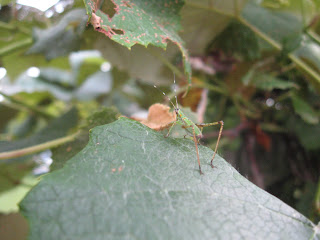Nothing in Biology is ever as simple as it seems. That’s the beauty of it, and this is especially true whenever insects enter the picture. Last June, I was scouting out my backyard for insects and other things, and came across a small, brightly-colored insect: vivid green and orange, it was almost neon. So what did I do? I snapped two pictures of it and moved on, not thinking much of it.
Scudderia sp. on a leaf of Vitis sp.
Obviously I wasn’t thinking very well that day. Returning to the pictures a little while later, I started to investigate to figure out what exactly it was. Truthfully, when I first saw it, I thought it was an assassin bug nymph. Actually, it’s a nymph of a bush katydid, genus Scudderia. An easy way to identify a Scudderia nymph is from their white and black-banded antennae.
Unfortunately, that’s about as far as I’ve gotten with this particular nymph. According to Bugguide, there are eight species of Scudderia (in North America at least). Ohio has five of them:
- S. curvicauda
- S. furcata
- S. fasciata
- S. pistillata
- S. texensis
Master of the Grape Leaf
Right now I’m leaning towards Scudderia furcata, the fork-tailed bush katydid, but I can’t say for sure until I get my hands on an identification guide. S. furcata and S. cuneata look similar, and based on pictures I’ve seen, this one looks like one of those species. And since the latter is distributed in the southeastern United States, the one in my picture seems likely to be S. furcata.
At any rate, even if I don’t know which species it is, it’s still a beautiful specimen. It’s interesting how colorful some insects can be—and how bright they can be. The adult form isn’t anything to go crazy over: it’s usually a plain green color, though sometimes you find a pink morph, which is pretty darn neat. It’s kind of sad that the adults lose the vibrant colors the young have...maybe as they grow, they shed their rebellious phase and go mainstream. Probably better to avoid being eaten.


Cool post! Those nymphs can be maddening when trying to figure out what they are. You might post on BugGuide and see if one of the experts can figure it out.
ReplyDeleteI was thinking about doing that Janet, though there's already a page full of unidentified Scudderia nymphs! I'll take a crack at it soon.
ReplyDelete